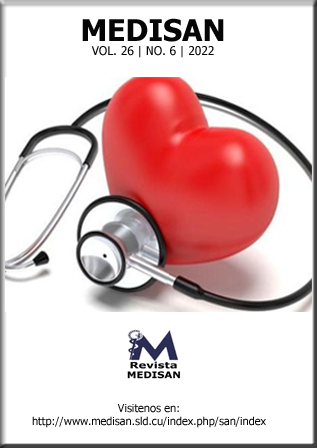Clinical epidemiological and imaging aspects of patients with human immunodeficiency virus/aids and diagnosis of neurotoxoplasmosis
Keywords:
acquired immunodeficiency syndrome, cerebral toxoplasmosis, opportunist infections, magnetic resonance.Abstract
Introduction: The acquired immunodeficiency syndrome is the final stage of a chronic, communicable and progressive disease of viral cause. The neurotoxoplasmosis is the most frequent opportunist infection in immunodepressed patients.
Objective: To characterize patients with secondary neurotoxoplasmosis to human immunodeficiency virus/aids according to epidemiological, clinical and imaging variables.
Methods: An observational, descriptive and cross-sectional study of 18 patients with AIDS was carried out, who received clinical and microbiological diagnosis of neurotoxoplasmosis, characterized according to findings in the magnetic resonance by images before and after the treatment, from January, 2017 to December, 2019.
Results: In the investigation there was a prevalence of the male sex, the ages of 34 or less years (66.7 %) and the clinical signs of fever (100.0 %) and headache (88.9 %). The most common localization of the lesions was in the cortico-subcortical juntion (66.1 %). The hypointense images in T1 and fluid attenuated inversion recovery and hyperintense images in T2 were the most frequent; the multiple lesions (66.7 %) of small size (50.0 %) and irregular contours (88.9 %) were notable. Before the treatment the enhance of anular type had more frequency (72.2 %) and grade 2 vasogenic edema (50.0 %); after this, 55.6 % of those affected persons presented calcifications and 72.2 % intralesional hemorrhages. It was evidenced that 77.8 % had improvement respect the cerebral edema.
Conclusions: The magnetic resonance by images allowed to characterize the patients with human immunodeficiency virus/aids and cerebral toxoplasmosis, as well as to evaluate the therapeutic response through the modifications in the imaging findings.
Downloads
References
2. Naranjo J, Mora A, Chacha P, Herrera JL, Venegas B. HIV y toxoplasmosis cerebral a propósito de un caso. Enfermería Investiga. 2021;6(5):85-9.
3. Zambrano Zunino CA, Rosero Ortega LY, Limones Moncada MS, Campaña Davila MY, Parra Zamora JA. Un acercamiento a la toxoplasmosis cerebral y su diagnóstico imagenológico. RECIMUNDO. 2019 [citado 12/10/2022];3(1):1558-78. Disponible en: https://www.recimundo.com/index.php/es/article/view/431/626
4. Rodríguez Jiménez J, Castañeda Cruz C, Osorio Aira S, Eiros Bachiller I, Parrado García SC, Peña Aisa A, et al. Toxoplasmosis cerebral en paciente VIH. Hallazgos radiológicos. 36 Congreso Nacional SERAM. 2022 [citado 12/10/2022];1(1):36 Disponible en: https://www.piper.espacio-seram.com/index.php/seram/article/view/9456/7922
5. Meini B. Un análisis socio-criminológico de la epidemia del VIH. Vernon Press. 2022 [citado 27/10/2022]. Disponible en: https://vernonpress.com/file/16479/cbfc8c1afe5dd567477a7ab815e917ad/1643803490.pdf
6. Tapia Rangel MG, Andino Rodríguez FX. Análisis de la capacidad funcional en pacientes con Toxoplasmosis Cerebral asociadas al Virus de la Inmunodeficiencia Humana que asistieron al Hospital de Infectología Dr. José Daniel Rodríguez Maridueña de Guayaquil. Pol. Con. 2022 [citado 27/10/2022];7(2):1778-93. Disponible en: https://polodelconocimiento.com/ojs/index.php/es/article/view/3679/8437
7. Cuba. Ministerio de Salud Pública. Anuario Estadístico de Salud. 2018. La Habana: MINSAP; 2019 [citado 27/10/2022]. Disponible en: https://files.sld.cu/bvscuba/files/2019/04/Anuario-Electr%C3%B3nico-Espa%C3%B1ol-2018-ed-2019-compressed.pdf
8. Cuba. Centro Provincial de Higiene, Epidemiología y Microbiología. Base de datos del Centro Provincial de Higiene y Epidemiología. Santiago de Cuba: CPHEM; 2018.
9. Puente Saní V, Romero García LI, Puente Hernández JC, Puente Hernández VM. Estado del arte, mortalidad y tendencia en el debut clínico de sida. Cuba Salud. IV Convención Internacional de Salud; 2022 [citado 27/10/2022]. Disponible en: https://convencionsalud.sld.cu/index.php/convencionsalud22/2022/paper/viewFile/1305/504
10. Huamán Vergara YM. Características personales y clínicas de pacientes con diagnóstico de VIH/SIDA atendidos en el Servicio de Medicina, Hospital Quillabamba, La Convención, Cusco 2015-2018 [tesis]. Cusco: Universidad Andina del Cusco; 2021 [citado 27/10/2022]. Disponible en: https://repositorio.uandina.edu.pe/bitstream/handle/20.500.12557/4713/Yulisa_Tesis_bachiller_2021.pdf?sequence=1&isAllowed=y
11. Suárez Rivero B, Belaunde Clausell A, Cardoso García D, Piloto Cruz A. La clínica en el diagnóstico de la neurotoxoplasmosis. Rev Méd Electrón. 2021 [citado 08/10/2022];43(6):1738-46. Disponible en: http://scielo.sld.cu/scielo.php?script=sci_arttext&pid=S1684-18242021000601738&lng=es
12. Coto Freund F, Murillo Barquero F, Rocha Monge SM. Encefalitis por Toxoplasma gondii en pacientes con virus de la inmunodeficiencia humana. Rev Médica Sinergia. 2021 [citado 08/10/2022];6(10):1-8. Disponible en: https://www.revistamedicasinergia.com/index.php/rms/article/view/723/1764
13. Sesé Lacámara DL, Costa Lorente DM, Guiral Foz P, Romero Martínez J, López Negredo D, Raymúndez Valhondo J, et al. Diagnóstico radiológico de las infecciones del sistema nervioso central (SNC). 36 Congreso Nacional SERAM. 2022 [citado 08/10/2022];1(1):36 Disponible en: https://www.piper.espacio-seram.com/index.php/seram/article/view/9344/7810
14. Lara Palacios IA, Canché Chi V, Ortiz Zolozaba P. Toxoplasmosis cerebral en un paciente con recién diagnóstico de VIH/SIDA. Salud Quintana Roo. 2018 [citado 08/10/2022];11(39):16-20. Disponible en: https://www.medigraphic.com/pdfs/salquintanaroo/sqr-2018/sqr1839d.pdf
15. Calero SR, Samitier Pastor A, Delgado Ricote C, Pasetto XS. Patología intracraneal asociada a VIH. 33 Congreso Nacional SERAM. 2018 [citado 08/10/2022]. Disponible en: https://piper.espacio-seram.com/index.php/seram/article/view/253/195
16. Carral L, Kaufer F, Pardini L, Durlach R, Moré G, Venturini MC, et al. Toxoplasmosis congénita: Diagnóstico serológico, RPC, aislamiento y caracterización molecular de Toxoplasma gondii. Rev Chil Infectol. 2018 [citado 18/10/2022];35(1). Disponible en: https://www.scielo.cl/scielo.php?script=sci_arttext&pid=S0716-10182018000100036&lng=es
17. Aljure VJ, Pulido Arias EA, Rodríguez Monroy JA, Rodríguez Mateus MN, Ramos Hernández JA. Diagnóstico diferencial de lesiones cerebrales con realce en anillo en tomografía computarizada y resonancia magnética. Duazary. 2016 [citado 18/10/2022];13(2):149-58. Disponible en: https://revistas.unimagdalena.edu.co/index.php/duazary/article/view/1721/1218
18. Brahim Salek M, Rodríguez Velasco M, Sigüenza González R, Santos Velasco P, Núñez Miguel E, Rodríguez Jiménez J. Abordaje del reto de realizar un correcto diagnóstico diferencial de LOES cerebrales con patrón de realce en anillo. 35 Congreso Nacional SERAM. 2021 [citado 18/10/2022];1(1). Disponible en: https://piper.espacio-seram.com/index.php/seram/article/view/4414/2880
19. Abrahantes Rodríguez Y, Pérez Ávila J, Kourí Cardellá V, Fonseca Gómez C, Baly Gil A, Tápanes Fernández T. Factores asociados a la progresión rápida a sida en individuos cubanos. Rev Cuban Med Trop. 2010 [citado 18/10/2022];62(2):146-53. Disponible en: http://scielo.sld.cu/scielo.php?script=sci_arttext&pid=S0375-07602010000200010&lng=es
Published
How to Cite
Issue
Section
License
All the articles can be downloaded or read for free. The journal does not charge any amount of money to the authors for the reception, edition or the publication of the articles, making the whole process completely free. Medisan has no embargo period and it is published under the license of Creative Commons, International Non Commercial Recognition 4.0, which authorizes the copy, reproduction and the total or partial distribution of the articles in any format or platform, with the conditions of citing the source of information and not to be used for profitable purposes.






